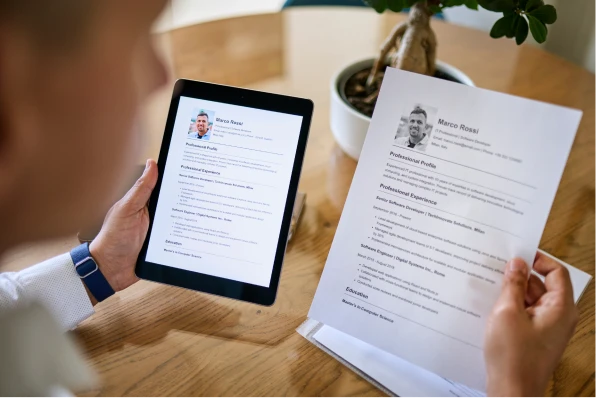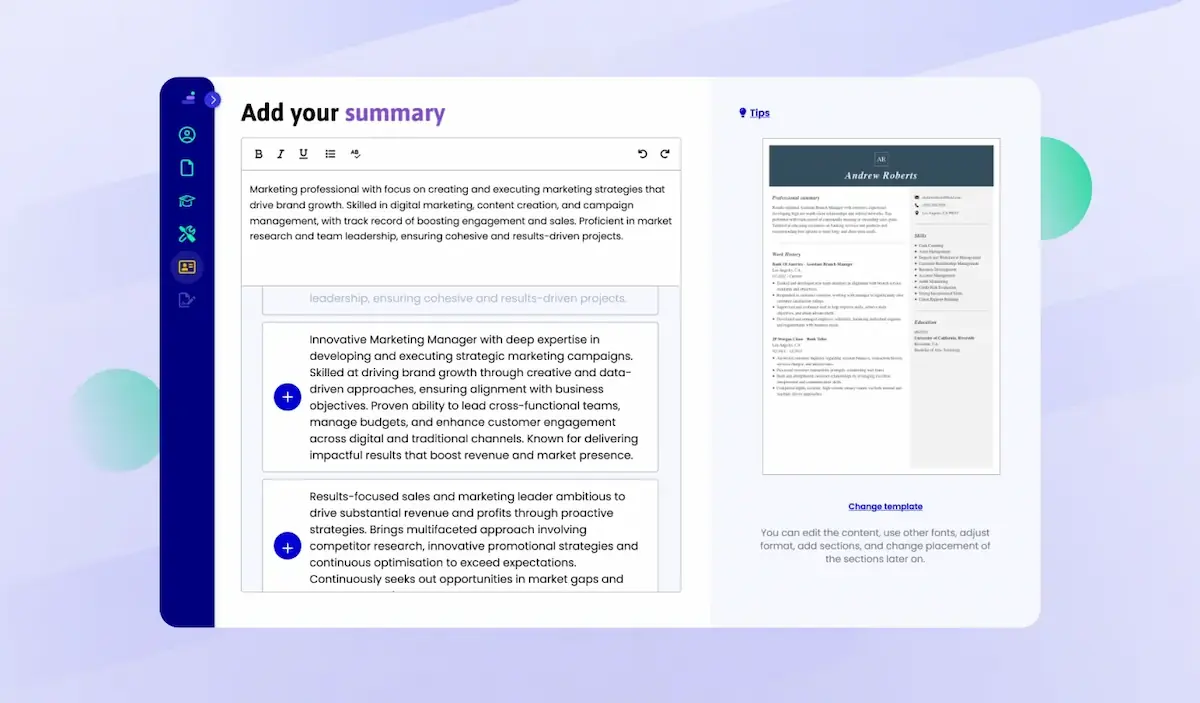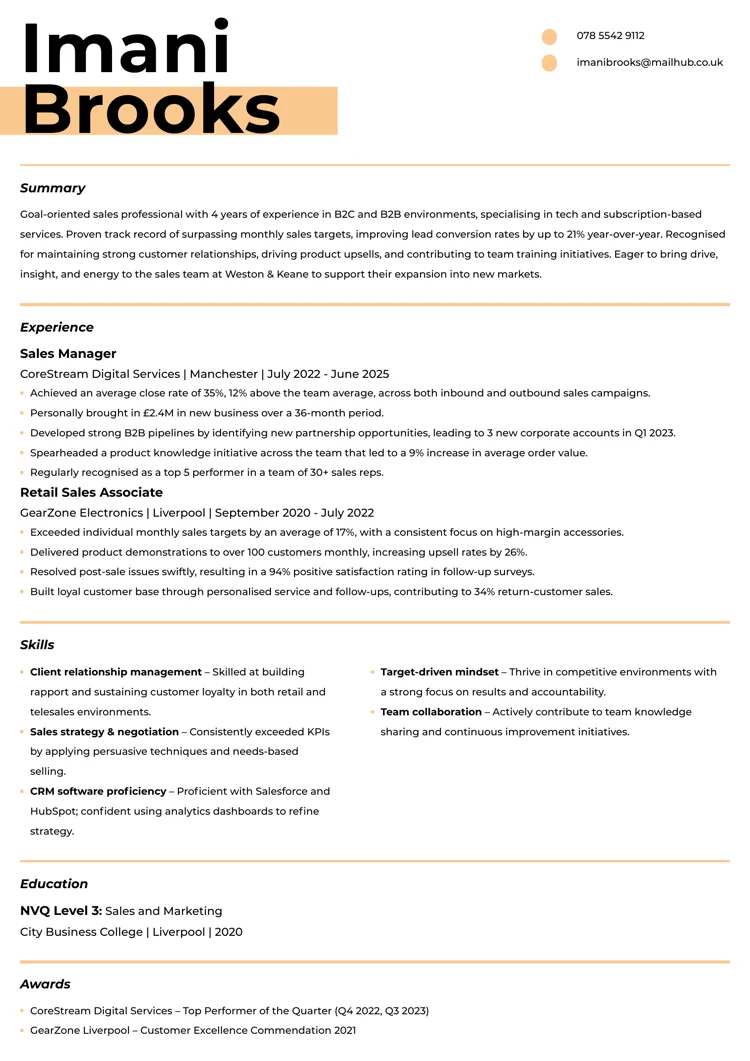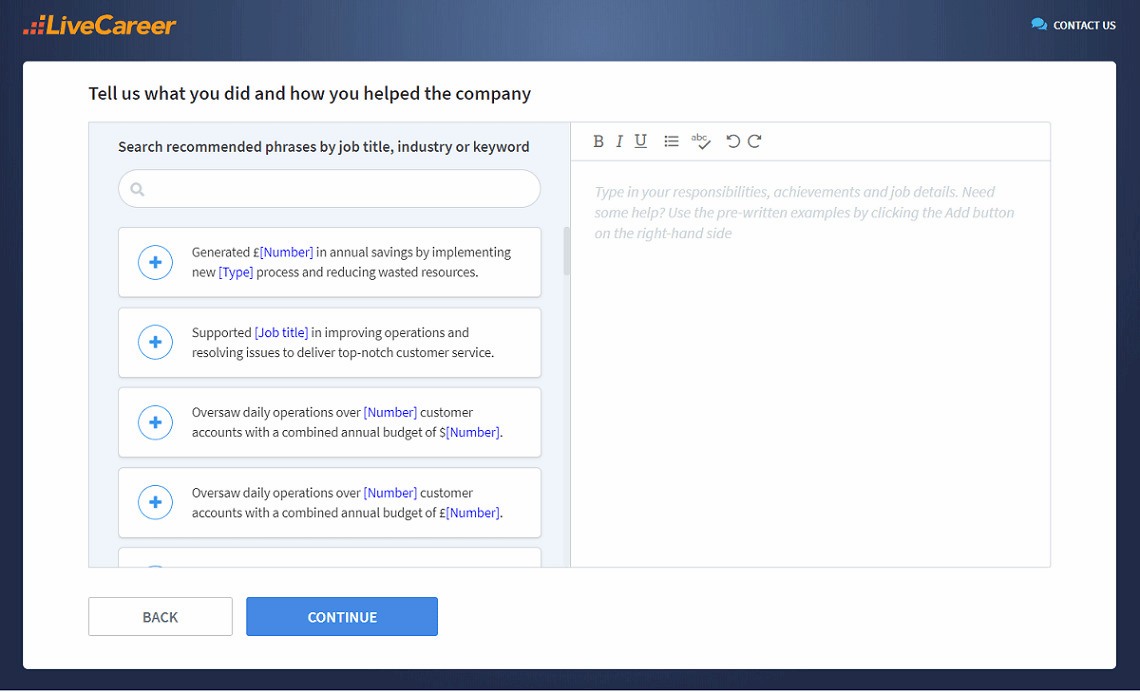
How to Write a Student CV (Tips, Examples & Template)
Not sure how to write a student CV? Discover all the student CV examples & writing tips you need, plus templates you can easily customise to your needs.
December 29, 2025
Last updated on 30 November, 2025

You’ve probably thought about what you should write in your CV, but have you given any thought to what a CV should look like? Creating a good impression with a professional-looking CV is just as important as having the right skills and experience.
I’ll teach you everything you need to know about what a CV should look like to get you one step closer to landing the job of your dreams. Plus, you'll get actionable tips to make your CV look outstanding and aligned with modern UK standards.
Wondering what a strong CV actually looks like? See it in action with our professional CV templates, and start creating your own in just minutes, thanks to our ready-to-use content and actionable expert tips along the way.

This sample CV was built in minutes using our builder. Explore other impressive CV examples and imagine how yours could look when created with LiveCareer CV builder.
When writing a CV from scratch, you might need extra help. Check these guides:
A good CV for the UK job market should cover certain essential sections in a clear and logical order. Think of your CV’s layout as a framework that highlights your most relevant information.
Here’s what a good CV should include, in the right order:
Contact details should go at the top of your CV. Put your name in a larger font, then add your phone number and professional email address. You can follow it with your city or region and a LinkedIn profile or portfolio link if relevant.
Expert advice: he focus should be on contacting you, not on unnecessary personal data, so skip your full address, date of birth, or a photo – UK employers do not require these, and omitting them helps prevent bias.
A CV personal profile, also referred to as a CV summary or CV objective, is a concise personal statement of 3–5 lines that introduces who you are, what you offer, and your career goals. Place this immediately after your contact info. Infuse it with a bit of personality and enthusiasm to engage the reader.
Yourwork experience sectionshouldbegin with your current or most recent job and proceed in reverse chronological order. For each role, include your job title, company name, location, and dates. Use 4–6 bullet points to highlight your primary responsibilities and, importantly, your key achievements, ideally with measurable results. Enhance the impact of bullet points by starting them with a CV action word and structuring them using the PAR (Problem-Action-Result) formula.
Start your educational background with the most recent qualification. List your degree or other diplomas, institution names, and dates. You can add notable achievements, such as graduating with first-class honours or completing relevant coursework.
Include a bullet-point list of your most relevant CV skills, ideally 6–10. It’s best to include a mix of soft skills and hard skills. Focus on abilities stated explicitly in the job posting to add CV keywords that are necessary to pass ATS checks.
Expert advice: Pay attention to keywords in the job posting. For instance, if the employer is looking for someone with “project management” and “Python programming,” make sure those appear in your skills or experience sections.
Include extra CV sections if they add value. Common additions include: certifications (relevant professional certifications or courses), volunteering experience, awards or honours, languages (with proficiency levels), or hobbies and interests.
Be selective: ask yourself if each extra detail will help you get the job. For most people, it’s best to avoid filling space with unrelated hobbies or trivial achievements.
Remember: The goal is to use your limited CV space for information that proves you’re the right candidate.

A CV that looks good isn’t about flashy design, but rather about clarity and consistency.
These design tips will ensure your CV looks polished:
A big part of what a CV should look like is selecting the correct CV format. Choose from:
Choosing the right CV font is crucial when determining the look of a CV. Stick to classic fonts like Arial, Calibri, Helvetica, or Verdana. The best font size is 10–12 points for body text, with slightly larger sizes for section headings to create natural breaks.
Expert advice: Avoid using fancy or overly artistic fonts. They may look creative, but they can make your CV more complicated to read for humans and ATS systems. I recommend sticking to just one font throughout your CV, as usingsing a few can make the text appear messy.
Don’t squash your text too tightly. Use margins of around 2–2.5 cm (0.75–1 inch) on all sides. Leave enough white space so the page doesn’t look cluttered. A bit of breathing room makes your CV more readable and professional.
Similarly, use a line spacing of approximately 1.15–1.5 for the body text to ensure clarity. Avoid walls of text by breaking up long paragraphs into bullet points and using short sentences. The person reviewing your CV will likely scan it quickly (remember, possibly just seconds at first glance), so make it skimmable.
Use clear headings (such as Education, Work Experience, and Skills) to guide the reader. It’s a good idea to bold or underline section titles or use a slightly larger font so they stand out. If a recruiter can instantly spot where each section is, they’ll find the information they need more quickly, which works in your favour. Some candidates even add subtle lines or design elements to separate sections; that’s fine as long as it remains professional.
Consistent formatting is the key to making a CV look good. Use the same style for headings, bullet points, dates, and fonts throughout your CV. Make sure dates are consistently aligned (either to the right or the left side), and verify that font sizes and colours are uniform. Small inconsistencies might seem minor, but they can disrupt flow and signal carelessness, which is precisely what you want to avoid in a good-looking CV.
Expert advice: Always use the spell check function with apps like Grammarly and Hemingway to ensure your CV is perfect. Research found that applications with only two spelling errors faced a significant penalty, experiencing a 7.3 percentage point reduction in interview probability.
How long should a CV be? Long enough to show off your skills and experience, but short enough to stay easy to read. Generally, a good-looking CV should be between one and two pages, depending on your experience level:
90% of companies use ATS software to streamline hiring, so your CV must be ATS-friendly. Avoid images or graphics that an ATS may not be able to read.
You know how to boost the readability of your CV, but we know how to achieve a well-written document in no time. Save time by choosing a ready-made personal content written by career experts and adjust it to your needs using the LiveCareer CV builder.

Choose from various content options and adapt them to fit a specific job offer you’re targeting. That’s personalisation 101 that will capture your readers' attention instantly.
When it comes to making a CV look good, using a CV template is a great idea. A well-designed CV template can save you time, ensure your CV looks professional, and help you get more job interviews.
LiveCareer UK CV templates come with these benefits:
Here are some examples of how your CV will look after you make it with LiveCareer UK CV builder:



Creating a strong CV is your first step to landing an interview, but knowing what to include and what to avoid can make all the difference. Small mistakes, irrelevant details or poor layout can quickly undermine your chances, no matter how impressive your experience.
Use this checklist of dos and don’ts to make sure your CV stands out for all the right reasons:
✅ Tailor your CV: Customise it for each job. Highlight the experiences, skills and keywords most relevant to the specific role.
✅ Keep it concise: Aim for 1 page if you have under 5–10 years’ experience; two pages if you have more. Focus on achievements, not every task.
✅ Use a clear layout: Use bold headings, bullet lists and white space to make your CV easy to skim.
✅ Emphasise achievements: Use active verbs and the PAR format to show how you added value.
✅ Mention both hard & soft skills: List technical skills (like software or tools) and interpersonal skills (leadership, communication) with examples of each in context.
✅ Include relevant keywords: Mirror terms from the job description to get past ATS and catch the recruiter's eye.
✅ Proofread carefully: Even minor errors hurt your credibility. Check spelling, grammar and contact details. (Remember: two typos can cut your interview chances significantly.)
Analysis of 6 million CVs made with LiveCareer UK CV builder reveals that*:
*The data comes from a period of 12 months (August 2023–August 2024).
⛔ DON’T include a photo or personal details: No headshots, DOB, marital status, etc.
⛔ DON’T lie or exaggerate: Employers can easily verify details, and any dishonesty will likely cost you the job.
⛔ DON’T send a generic CV: Employers notice if a CV isn’t tailored to their role.
⛔ DON’T clutter the layout: Avoid tiny fonts, dense paragraphs or gimmicky graphics. Fancy designs can confuse ATS and overload the reader.
⛔ DON’T list irrelevant jobs or hobbies: Only include roles or activities that support your suitability for this job. Cut anything that doesn’t add value.
⛔ DON’T use slang or abbreviations: Keep language professional. Write dates and details in full (e.g. “January 2025,” not “Jan ’25”). Avoid contractions (“I am” instead of “I’m”).
⛔DON’T forget to update it: A CV is a living document. Make sure that all information (degrees, contact details, recent achievements) is up to date before sending it.
Ready to put all this advice into practice? You don’t need to be a CV expert to get results, because our builder makes it easy for anyone to create a job-winning CV.

No matter your industry or experience level, LiveCareer’s CV builder has you covered with recruiter-approved ATS-friendly templates and content. Build your CV today and step into your next job with confidence.
Thank you for reading this guide on how a CV should look. I hope this guide has provided valuable insights into creating a polished, effective document that helps your job search. Good luck writing your CV!
Our editorial team has reviewed this article for compliance with LiveCareer’s editorial guidelines. It’s to ensure that our expert advice and recommendations are consistent across all our career guides and align with current CV and cover letter writing standards and trends. We’re trusted by over 10 million job seekers, supporting them on their way to finding their dream job. Each article is preceded by research and scrutiny to ensure our content responds to current market trends and demand.
Category: CV Help
Crafting a job-winning CV is all about showcasing your unique skills and experiences. Start with a strong personal statement that highlights your career goals and achievements.
Try Our CV Builder Now